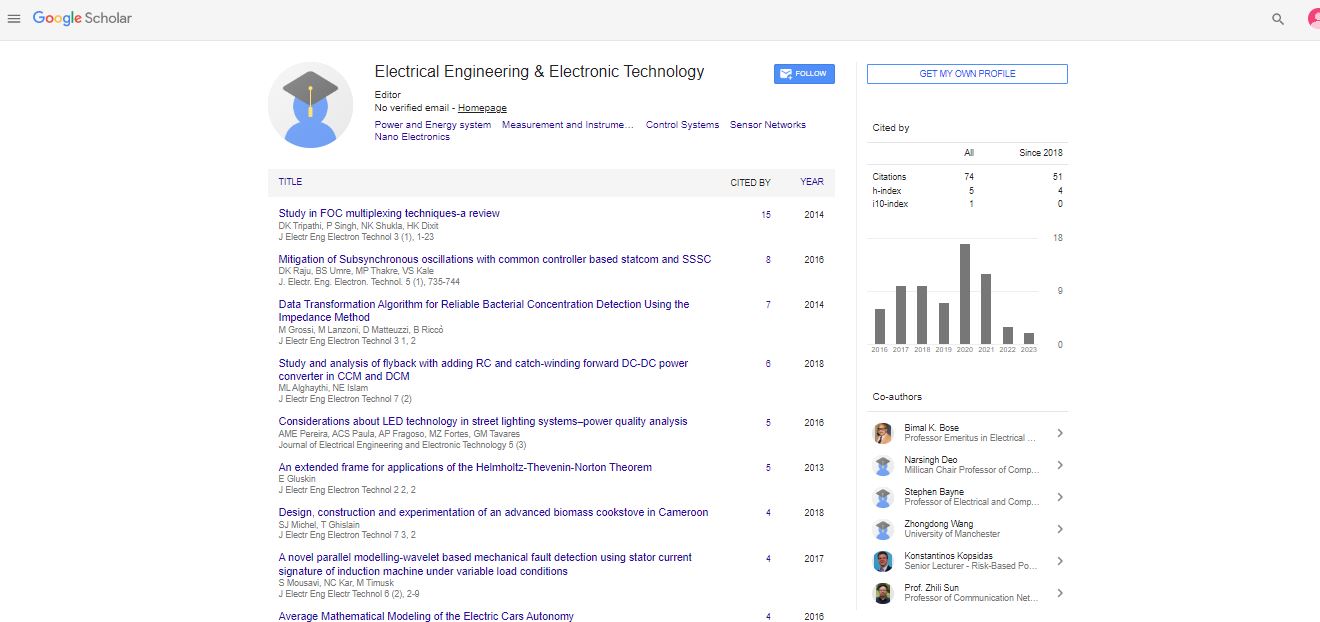Editorial, J Electr Eng Electron Technol Vol: -14 Issue: -2
Robotics, Automation & Cobots: Revolutionizing Modern Industry
Rubina Wakas*
Department of Microelectronics, University of Baghdad, Iraq
- *Corresponding Author:
- Rubina Wakas
Department of Microelectronics, University of Baghdad, Iraq
E-mail: wakas746@gmail.com
Received: 01-Mar-2025, Manuscript No. jeeet-25-170134; Editor assigned: 4-Mar-2025, Pre-QC No. jeeet-25-170134 (PQ); Reviewed: 18-Mar-2025, QC No. jeeet-25-170134; Revised: 25-Mar-2025, Manuscript No. jeeet-25-170134 (R); Published: 31-Mar-2025, DOI: 10.4172/2325-9838.10001005
Citation: Rubina W (2025) Robotics, Automation & Cobots: Revolutionizing Modern Industry. J Electr Eng Electron Technol 14: 1005
Introduction
In recent decades, the integration of robotics and automation has transformed industries around the globe. From manufacturing floors to healthcare, these technologies are redefining how work is done by increasing efficiency, precision, and safety. Among the emerging advancements, collaborative robots, or cobots, represent a new frontier, designed to work alongside humans rather than replace them. Understanding the roles and impact of robotics, automation, and cobots provides insight into the future of work and innovation [1].
Discussion
Robotics broadly refers to machines designed to perform tasks autonomously or semi-autonomously. Early industrial robots were programmed to perform repetitive and precise tasks such as welding, assembly, or packaging. These robots operate in structured environments, typically isolated from human workers for safety reasons. The advantages of robotics include increased productivity, consistency in quality, and the ability to perform dangerous or physically demanding jobs [2].
Automation takes robotics further by integrating control systems, software, and sensors to create processes that can operate with minimal human intervention. Automation is not limited to physical robots; it includes software bots that perform repetitive tasks such as data entry or customer service through artificial intelligence (AI). In manufacturing, automation streamlines production lines, reduces human error, and allows for real-time monitoring and adaptation [3].
However, the traditional model of industrial robotics and automation often involved large-scale, expensive systems requiring specialized operators. This is where cobotsâ??collaborative robotsâ??introduce a paradigm shift. Unlike conventional robots that work behind safety cages, cobots are designed to safely work side by side with humans. Equipped with sensors and advanced AI, cobots can detect human presence and adapt their actions to ensure safety. They are more flexible, easy to program, and cost-effective, making automation accessible to small and medium-sized enterprises [4].
Cobots excel in roles that require human-robot interaction, such as assisting workers in assembly tasks, quality inspection, or material handling. They enhance human capabilities rather than replace them, taking over repetitive or ergonomically challenging parts of the job and allowing workers to focus on complex decision-making or creative problem-solving.
The combination of robotics, automation, and cobots is fostering smarter factories and workplaces. Advances in machine learning and AI are enabling robots and cobots to learn from their environment and improve over time. This synergy is leading to increased productivity, reduced operational costs, and improved workplace safety [5].
Conclusion
The evolution of robotics and automation, highlighted by the rise of cobots, is reshaping industries across the world. These technologies bring not only efficiency and precision but also the potential for more human-centric work environments. As cobots continue to integrate with human workers, they promise to create safer, more flexible, and more innovative workplaces. The future of robotics lies not in replacing humans but in collaborating with them to unlock new possibilities for productivity and creativity.
References
- Glassman PM, Balthasar JP (2019) Physiologically-based modeling of monoclonal antibody pharmacokinetics in drug discovery and development. Drug Metab Pharmacokinet 34:3-13.
- Wang Y, Zhu H, Madabushi R, Liu Q, Huang SM, et al. (2019) Modelâ?informed drug development: current US regulatory practice and future considerations. Clin Pharmacol Ther 105:899-911
- Daubner J, Arshaad MI, Henseler C, Hescheler J, Ehninger D, et al. (2021) Pharmacological neuroenhancement: current aspects of categorization epidemiology pharmacology drug development ethics and future perspectives. Neural Plast 2021:8823383
- Löscher W (2017) Animal models of seizures and epilepsy: past, present, and future role for the discovery of antiseizure drugs. Neurochem Res 42:1873-1888.
- Sequeira AJ, Buchman S, Lewis A, Karceski S (2018) Future development of a depot antiepileptic drug: What are the ethical implications? Epilepsy Behav 85:183-187.
Indexed at, Crossref, Google Scholar
Indexed at, Crossref, Google Scholar
Indexed at, Crossref, Google Scholar
Indexed at, Crossref, Google Scholar
 Spanish
Spanish  Chinese
Chinese  Russian
Russian  German
German  French
French  Japanese
Japanese  Portuguese
Portuguese  Hindi
Hindi 
